Rhine
The Rhine River spans Central Europe and Western Europe. It flows through or along the borders of Switzerland, Liechtenstein, Austria, Germany, France and The Netherlands. It is a major navigation way and played an important role in history and culture of Europe.
- This article is an itinerary.
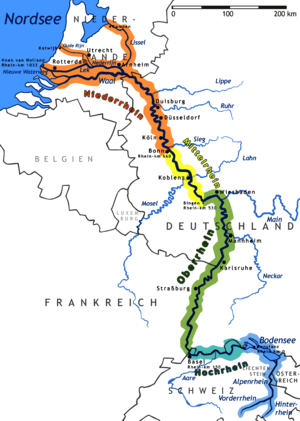
Understand
The Rhine is 1,233 km long, from its source(s) in the Swiss Alps of Graubünden to its delta estuary on the North Sea, making it the seventh-longest river in Europe (if longer tributaries of the Volga are not counted). Given its location in Central Europe and its course through several densely populated countries and regions, its importance to history, economy, transport and culture, is much greater than its sheer length might suggest.
The name Rhine (Rhenus in Latin; Rhein in German, Rhin in French, Rijn in Dutch) is probably derived from the Indo-European radical rei- and therefore etymologically related to the words rheo (Old Greek for "to flow"), rinnen (German for "to trickle"), Latin rivus, Spanish rio and English river. The Rhine is grammatically male in Latin, French, German and Dutch, and personified as a male river deity (Rhenus Pater or "Father Rhine") in art.
The Rhine has both connected and divided Europeans through the centuries. For the Roman Empire, it became part of the Limes Germanicus; Roman rule of land north of the Rhine was short. Since then it has been the divide between Germanic and Romance languages. Today it is the border of France and Germany, two nations that clashed in two World Wars, but since then have contracted a close friendship. Some territories along the Rhine (Alsace and the German territories west of the Rhine) have changed their affiliation between Germany and France back and forth through the centuries. The Rhine is proverbially referred to as the "river of fate of the Germans" and "the most German of all rivers", often portrayed by romantic and nationalist painters and poets (most notably however by Heinrich Heine who had a rather difficult relationship to his country of birth and eventually emigrated, ironically, to France). The French Republic chose the "War Song for the Rhine Army" (better known as La Marseillaise) as its national anthem, while Die Wacht am Rhein ("The Watch on the Rhine") was a popular patriotic song in Germany during the late-19th and early-20th century, serving as a de facto national song (in default of an official one), and the national anthem of Liechtenstein starts with the verse Oben am jungen Rhein ("Up above the young Rhine"). Two French departments (Haut-Rhin and Bas-Rhin, both in Alsace) and two German states (Rhineland-Palatinate and North Rhine-Westphalia) are named after the Rhine.
Many legends and folktales are linked to the Rhine, most notably the early-medieval "Song of the Nibelungs" (Nibelungenlied) telling the story of the dragon-slayer Siegfried, and the Lorelei legend of a beautiful witch, nixie or nymph, sitting on top of a hill watching over the Rhine and dazzling the skippers who thus lose control of their vessels and steer them against the rocks. Both have inspired many poets and composers, especially during the 19th century era of romanticism (think of Richard Wagner's "Ring of the Nibelung" or Friedrich Silcher's tune to Heinrich Heine's Loreley poem).
There are eleven UNESCO World Heritage sites along, or close to, the course of the Rhine: the cultural landscape of the upper Middle Rhine Valley with its vineyards and medieval castles; the old town of Strasbourg; three monasteries, two cathedrals, prehistoric pile-dwellings, a fortress from the 1700s, an ensemble of Baroque châteaux, and a group of windmills.
The Rhine is commonly divided into the following parts:
- Head waters: Anterior Rhine and Posterior Rhine
- Alpine Rhine (Alpenrhein) – from Graubünden to Lake Constance.
Ruinaulta (Rheinschlucht) – canyon created by the Vorderrhein. - Lake Constance (Bodensee), consisting of the Upper and Lower Lake that are linked by the 4-km-long Seerhein ("Lake Rhine"). The official kilometrage of the Rhine for river navigation begins at Constance (km 0).
- High Rhine (km 0–167; Hochrhein) – from Lake Constance to Basel in Switzerland.
Rhine Falls (km 48; Rheinfall) near Schaffhausen, the second-biggest waterfall in Europe, measured by its potential energy - Upper Rhine (km 167–529; Oberrhein) – between Basel and Bingen / Rüdesheim, Germany
- Middle Rhine Valley (km 529–659; Mittelrheintal) — the most famous and scenic part of the Rhine between Bingen /Rüdesheim and Bonn / Bad Honnef, with countless wineries and the famous Lorelei rock
- Lower Rhine (km 659–867; Niederrhein) – from Bonn and Cologne into the Ruhr area and the rural northwesternmost corner of Germany.
- Rhine–Meuse–Scheldt delta (km 867–1033) – Behind the German–Dutch border, the Rhine splits into dozens of branches, forming a vast delta that covers much of the Netherlands. The Meuse, that used to be an independent river with its own estuary, became a tributary of the Rhine in 1970 due to the construction of the Delta Works. Confusingly, two of the Rhine's main estuaries are called "Old Meuse" and "New Meuse".

Prepare
Get in
By plane
The closest airports to the starting point of this itinerary are the major international airport of Zurich (ZRH; 135 km from Tamins, 2 hours by train and bus) and the much smaller one of Saint Gallen (ACH; 100 km). The closest airports to its terminal point are Amsterdam (AMS; 65 km from the Hook of Holland, 1–1:15 h by train), which again is a major international hub, and the less significant Rotterdam (RTM; 30 km, one hour by train and bus).
If you do not plan to cruise the whole length of the Rhine, you can use the Euroairport Basel-Mulhouse (BSL/MLH/EAP; High Rhine and Upper Rhine), Frankfurt (FRA; Upper Rhine and Middle Rhine), Cologne (CGN; Middle Rhine and Lower Rhine) or Düsseldorf (DUS; Lower Rhine), all of which are major international airports close to the course of the Rhine. Moreover, there are minor airports at Friedrichshafen (FDH; Lake Constance), Karlsruhe-Baden (FKB; Upper Rhine) and Weeze-Niederrhein (NRH; Lower Rhine), mostly served by low-cost carriers.
By train
The closest intercity station to the source of the Rhine is Chur, which is served by frequent intercity trains from Zurich and Basel, buses from Bellinzona, and even a direct ICE high-speed train from Hamburg, Hanover and Frankfurt once a day (that does not, however, travel faster than an ordinary intercity within Switzerland). The station of Reichenau-Tamins, only a few hundred metres from the confluence of Anterior and Posterior Rhine (i.e. the origin of this itinerary), is reached by suburban and regional trains from Chur several times per hour in 8–12 minutes.
The closest intercity station to the estuary of the Rhine into the North Sea is Rotterdam Centraal, served by Thalys high-speed trains from Amsterdam (both central station and Schiphol airport) and Bruxelles, Intercity Direct (ICD) from Amsterdam and Breda, as well as intercity trains from Utrecht, Groningen, Amersfoort, Leeuwarden. It is connected with the Hook of Holland (Hoek van Holland Haven station) by half-hourly "Sprinter" (i.e. regional express) trains, every second train (=hourly) continues to Hoek van Holland Strand, which is even closer to the estuary mouth.
Other major rail hubs along the route are Basel (TGV from Paris, ICE from Berlin, Cologne, Hamburg, Frankfurt), Strasbourg (TGV from Paris, Lyon, Bruxelles, Frankfurt), Mannheim (ICE from all parts of Germany, Basel, ICE or TGV from Paris), Frankfurt (ICE from all parts of Germany, Paris, Amsterdam, Vienna), Cologne and Düsseldorf (both with ICE from all parts of Germany, Amsterdam, Thalys from Paris, Bruxelles).
Go
By bicycle
- EuroVelo 15 – the Rhine Cycle Route (Rhein-Radweg or Rijn-Fietsroute) – from Andermatt to Rotterdam.
By foot
- Rhine Valley Switzerland
- Rheintaler Höhenweg from Sargans to Rorschach (Lake Constance)
- Middle Rhine Valley (Bingen/Wiesbaden to Bonn), Germany
- Rheinhöhenweg Trail
- Rheinburgenweg Trail on the left Rhine side
- Rheinsteig Trail on the right Rhine side
Cruise ships
There are many luxury cruise liners along the river, some just short sections other going from the whole length or into the Main river and to the Danube.
From Amsterdam to Basel, Zurich or Strasbourg or from the Rhine cruise up the Main and Danube to Budapest. The leisurely journey with plenty of stopovers typically takes anywhere from one to two weeks, with accommodation on the boat itself. Large operators include Avalon and Viking.
The Köln-Düsseldorfer Rheinschiffahrt, better known as KD, runs cruises and scheduled services up and down the river between Cologne and Mainz.
Alpine Rhine
- Tamins, confluence of the two headwaters, Anterior and Posterior Rhine. Frequent rail and bus links from/to Chur.
- Chur. Frequent rail links (suburban train, regional express, intercity) to Sargans. Regional express trains follow the course of the Rhine from here to St. Margrethen on the Alpine Rhine delta and Rorschach on Lake Constance (bypassing Liechtenstein, but stopping in Buchs on the Liechtenstein border)
- Haldenstein: 12th-century ruined castles and Renaissance castle from the 16th century
- Sargans on the Swiss-Liechtenstein border. Starting point of the Rheintaler Höhenweg (hiking trail). Two-hourly buses from here to Balzers, Vaduz, Schaan. Or continue by train to Buchs SG which is just on the opposite side of the border from Schaan.
- Balzers
- Vaduz
- Schaan. Bus or Train to Buchs SG.
- Buchs: Werdenberg Castle. Continue by regional express to St. Margrethen or Rorschach.
Alpine Rhine delta: The Alpine Rhine splits into several branches issuing into Lake Constance (much smaller, of course, than the Rhine delta at the North Sea)
- St. Margrethen. Here you have to decide if you want to circuit Lake Constance on its southern or its northern shore. Hourly S-Bahn to Bregenz (Austria).
Lake Constance
- Southern bank
- Rorschach. End of the Rheintaler Höhenweg. S-Bahnen (suburban trains) connect from here to Schaffhausen (via Romanshorn, Kreuzlingen, Stein am Rhein).
- Possible detour to Saint Gallen (12 km south of Lake Constance, 15–20 min by train from Rorschach): the elaborate Baroque library of the former Benedictine abbey is a World Heritage site
- Romanshorn
- Kreuzlingen. Constance's Swiss twin city. To go to Constance, get off the train here and just walk across the border (less than 1 km) or take bus 908 or 925.
- Constance (Konstanz)
- Salenstein: Arenenberg mansion with Napoleon museum
- Mammern: Liebenfels Castle
- Eastern and Northern bank
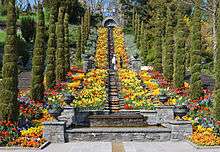
- Bregenz (Austria). Famous for its annual opera and music festival with a stage on the lake. Frequent rail links (S-Bahn, regional express) to Lindau.
- Lindau. Very picturesque old town on an island in Lake Constance. Half-hourly trains to Friedrichshafen.
- Friedrichshafen. City of the Zeppelin airships. Hourly interregio express (IRE) from here to Basel (via Überlingen, Radolfzell, Schaffhausen). Half-hourly buses to Meersburg, Uhldingen and Überlingen.
- Meersburg
- Uhldingen-Mühlhofen, prehistoric lakeside pile dwellings, reconstructed as part of an archaeological open-air museum; Baroque pilgrimage church of Birnau. Ferry to Mainau.
- Überlingen
- Bodman-Ludwigshafen: given that Tuttlingen on the Danube is just 30 km from here, this is the most convenient point to change from the Rhine to the Danube itinerary (or vice versa). Interestingly, while both rivers are so close to each other (separated only by the watershed of the Hegaualb mountains), one drains into the North Sea, while the other runs 2800 km southeast to empty into the Black Sea.
- Mainau – the "flower island"
- Constance (Konstanz). Half-hourly local trains to Radolfzell (via Reichenau).
- Reichenau. Another picturesque island in Lake Constance with a Romanesque Benedictine abbey whose collection of medieval book paintings is part of the UNESCO Memory of the World Programme.
- Radolfzell. Hourly interregio express from here to Basel (via Singen, Schaffhausen). To go to Stein am Rhein, get off the train at Singen and transfer to a bus.
High Rhine

forms the border between Germany and Switzerland
- Stein am Rhein. Charming old town with remarkably adorned Renaissance buildings. Half-hourly S-Bahn to Schaffhausen.
- Schaffhausen. Half-hourly S-Bahn or even more frequent local buses to the Rhine falls. Hourly interregio express to Basel (via Waldshut-Tiengen, Bad Säckingen, the German part of Rheinfelden).
- Rhine Falls
- Küssaberg: Küssaburg castle
- Waldshut-Tiengen. The IRE does not stop in Laufenburg; if you want to visit that place, change here to a regional train that stops at every station on the way to Basel.
- Laufenburg. From here, there is an S-Bahn to Basel every hour, running on the Swiss side of the river (via Stein-Säckingen, Rheinfelden, (Kaiser-)Augst)
- Bad Säckingen
- Rheinfelden
- Augusta Raurica, ancient Roman city, in today's town of Augst
Upper Rhine (Basel–Karlsruhe)
- Basel. There is a northbound rail route to Karlsruhe running approximately parallel to the Rhine, but not following the course of the river exactly. To go to Breisach, you have to leave the regional express Basel–Offenburg at Bad Krozingen and change to a bus; or go via Freiburg, a lovely and livable city, albeit not on the Rhine. Another rail route runs parallel on the French side of the border, directly to Strasbourg (via Mulhouse, Colmar). It is served by regional express trains (TER), at least once an hour, but the route is not very close to the river (nearly 20 km off its banks).

From here the Rhine forms the border between France and Germany
- Weil am Rhein: Vitra Design Museum
- Breisach, Romanesque to Gothic St. Stephen's minster with Renaissance mural by Martin Schongauer. Hourly buses to Neuf-Brisach and back.
- Neuf-Brisach, perfectly preserved, star-shaped Baroque fortification, designed by the famous French fortress architect Vauban, UNESCO World Heritage
- Sasbach am Kaiserstuhl: Limburg (ruined spur castle)
- Europa Park, amusement park in Rust
- Take a boat-tour in the Taubergießen a floodplain wetland.
- Kehl. Local trains connect to Strasbourg at least once an hour.
- Strasbourg, capital of the Alsace region that has a mixed French and German heritage; seat of the European Parliament, Council of Europe and European Court of Human Rights. The historic old town on the Grande Île is a World Heritage site. There are direct ICE and TGV high-speed trains from here to Karlsruhe. If this is too fast for you, take a regional express train (TER) to Lauterbourg and connect to a cross-border regional train to Wörth am Rhein.
- Rheinmünster-Schwarzach: Romanesque priory
- Rastatt
Upper Rhine (Karlsruhe–Bingen)
Hereafter the Rhine flows solely in Germany

- Karlsruhe. Conservation centre (Naturschutzzentrum) Karlsruhe-Rappenwört informs about biodiversity in the Rhine meadows. There are two-hourly regional express trains along the Rhine from here to Mainz on the left bank of the Rhine (via Speyer), as well as regional trains to Mannheim on the right bank (via Hockenheim and Schwetzingen).
- Wörth am Rhein
- Speyer, the cathedral is the largest extant Romanesque cathedral in Europe and a World Heritage site. Buses connect between Speyer Domplatz (cathedral place) and Hockenheim twice an hour.
- Hockenheim, known for the motorsport racing circuit
- Schwetzingen, Baroque palace and park
- Possible detour to Heidelberg: the old town is one of the most popular tourist destinations in Germany; only 20 km off the confluence of Neckar and Rhine (15 minutes from Mannheim by train)
- Mannheim. Regional express trains follow the course of the Rhine from here to Mainz (via Ludwigshafen, Frankenthal, Worms). Slower regional trains take the same route but stop at every station on the way.
- Ludwigshafen
The left-hand bank of the following section (belonging to the state of Rhineland-Palatinate) is called Rhenish Hesse (Rheinhessen). It is one of Germany's most important wine-growing regions.

- Worms, history-charged city with another impressive Romanesque imperial cathedral, associated with the early-medieval Nibelungen legend and Martin Luther's steadfast profession of his Protestant faith.
- Possible detour to Lorsch (14 km east of the Rhine; 20 minutes by train from Worms) with its World Heritage Carolingian Benedictine abbey.
- Oppenheim
- Confluence of Rhine and Main
- Mainz, state capital of Rhineland-Palatinate with the third of the imperial cathedrals on the Upper Rhine; home of Johannes Gutenberg, inventor of movable type printing. A much frequented rail route exactly follows the course of the Rhine (on the left-hand bank) from Mainz via Koblenz and Bonn to Cologne with many scenic views of the Middle Rhine Valley. It is used by regional, intercity and some ICE trains. Other ICEs however use the high-speed track from Frankfurt to Cologne, you should avoid them as they bypass the beautiful Rhine Valley and you cannot identify any landscape outside the window at all as 300 kph is just too fast for the human eye. Instead you could opt for the regional express train Mainz–Koblenz that stops in Ingelheim, Bingen, Bacharach, Oberwesel and Boppach; or the even slower regional train that stops at every station. KD ships cruise the Rhine daily from here to Boppard and Bonn (only during high season, late April to 3 October).
- Wiesbaden, city of spas and casino, starting point of the Rheinsteig hiking trail. From Wiesbaden, another rail route escorts the river on its right-hand bank. It is frequented by hourly VIAS trains from Frankfurt via Wiesbaden and Koblenz to Neuwied that stop at all stations on the way.
Between Mainz/Wiesbaden and Koblenz (more than 80 km), there is no bridge across the Rhine. You can cross the river with ferries, or just stay on one of the two sides (and visit the other next time).
The right-hand bank of the following section (that belongs to the state of Hesse) is called Rheingau and famous for its wine, too. The left-hand bank still belongs to Rhenish Hesse, so you will find wine villages on both sides.
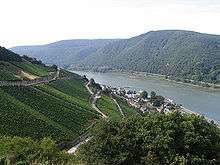
- Eltville: Kloster Eberbach is one of the oldest and biggest former Cistercian abbeys in Germany with several Romanesque and Gothic buildings.
- Ingelheim
- Oestrich-Winkel
- Gau-Algesheim
- Geisenheim
- Rüdesheim. Niederwald national monument erected in 1883 to commemorate the victory over France and the foundation of the German Empire in 1870/71. Daily cruise ships from here to Koblenz (Easter–late October) and Bonn (only late April–3 October)
- Bingen, starting point of the Rheinburgenweg.
Upper Middle Rhine

This section is considered to be one of the most scenic landscapes of Germany and noted for its many romantic, high-medieval hilltop castles on either side of the stream. The whole cultural landscape of the upper Middle Rhine Valley is listed by UNESCO as part of the World Heritage.
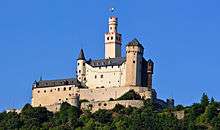
- Assmannshausen
- Trechtingshausen, Rheinstein Castle
- Lorch
- Bacharach. Two-hourly cruise ships from here to Boppard (high season; only thrice a day during low season)
- Kaub, Pfalzgrafenstein (14th-century toll station in the middle of the river)
- Oberwesel, Schönburg castle
- Loreley, legendary rock on whose top a beautiful witch is said to have turned the head of many a skipper, resulting in their death by drowning.
- Sankt Goar, Rheinfels Fortress
- Sankt Goarshausen, Katz & Maus ("cat and mouse") castles
- Boppard
- Braubach, Marksburg castle
- Lahnstein

- Koblenz, the confluence of Rhine and Moselle (the name Koblenz is derived from the word "confluence") is called Deutsches Eck ("German corner") and considered to be a symbolic place of this nation. There is a larger-than-life equestrian statue of German Emperor William I (the first ruler after the German unification of 1870/71) right on the point between the two rivers. Exactly opposite is the massive Ehrenbreitstein fortress. Terminus of the regional trains from Mainz. From here hourly regional express trains follow the Rhine all the way to Emmerich on the German-Dutch border (via Bonn, Cologne, Düsseldorf, Duisburg). If you prefer to travel more slowly, take the regional train Koblenz–Cologne that stops at every station.
Lower Middle Rhine

- Vallendar
- Bendorf
- Neuwied, extensive landscape park Monrepos, created in the 18th and 19th century. Terminus of regional trains from Frankfurt/Wiesbaden. Train travellers on the right bank of Rhine may continue by regional express in the direction of Mönchengladbach (via Linz, Bad Honnef, Königswinter, Bonn-Beuel), or the slower regional train to Rommerskirchen that stops at every station.
- Possible detour to Maria Laach abbey (12 km southwest of the Rhine, 40 minutes by bus from Andernach), one of the best-preserved Romanesque monasteries in Germany, basilica with unique narthex.
- Bad Hönningen: Cruise ships from here to Cologne (only Sun-Tue during high season).
- Linz am Rhein: Cruise ships from here to Bonn (daily during high season, only Fri-Sun during low season) and Cologne (daily during high season, Fri-Sun on the Easter weekend and mid-October)
- Remagen, end of the Rheinburgenweg. Ruined Rolandseck castle and Arp Museum Rolandseck. Site of a famous WWII battle fought over one of the last intact Rhine crossings
- Bad Honnef
- Königswinter, with the 321-metre-high Drachenfels hill, one of the most picturesque and most frequently summited mountains in Germany, topped by a romantic castle
- Bonn, former capital of West Germany, end of the Rheinsteig
Lower Rhine

- Possible detour to Brühl, the Baroque palaces of Augustusburg and Falkenlust (UNESCO World Heritage sites) are just 5 km off the Rhine's western bank.
- Cologne-Porz: The recreational park Groov is located on a former island, created by a silted anabranch of the Rhine.
- Cologne (Köln), the biggest city on the river Rhine with a two millenia old history. The landmark Gothic cathedral that was under construction for more than six centuries, is a World Heritage site. Cologne is an important traffic hub, if you want to cruise only a section of the Rhine, this is a good place to start or end your tour. The left-bank regional trains from Koblenz end here. You may connect to regional express trains that follow the Lower Rhine to Emmerich (partly on the western, partly on the eastern bank).
- Leverkusen
- Neuss
- Düsseldorf, state capital of North Rhine-Westphalia, international trade city and Germany's fashion capital. Regional express trains from Koblenz to Emmerich cross the Rhine and continue on its right-hand bank (via Duisburg, Oberhausen, Wesel), bypassing Meerbusch, Krefeld and Xanten. If you want to continue on the left side, change to the half-hourly regional train to Kleve (via Meerbusch, Krefeld).
- Meerbusch
- Krefeld. Regional trains to Duisburg.
- Duisburg, westernmost city of the Ruhr, with Europe's biggest inland harbour. On the right side of the Rhine, you may continue with the regional express to Emmerich or (slower) regional train to Wesel, on the left bank there are regional trains to Xanten (via Moers). Moreover, two-hourly ICE high-speed trains continue directly to Arnhem (only stopping in Oberhausen, but no other town on the Lower Rhine).
- Wesel. On a former island, formed by the Rhine and a silted anabranch, is Germany's biggest campsite.
- Xanten, history dating back to the Roman era, archeological park containing the sites of the ancient city Vetera. Rail service on the left bank of the Rhine ends here, however there are hourly buses to Kleve.
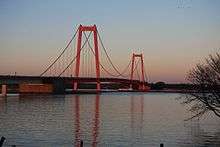
- Emmerich am Rhein. While a cross-border rail route to the Netherlands does exist, there are no local trains crossing the border (only ICEs that do not stop in Emmerich). However, there are hourly buses to Nijmegen. Alternatively, you could take a taxi to the Dutch border town of Zevenaar and countinue by local train to Arnhem.
- Kleve. The left-bank rail route ends here, but there are hourly buses to Nijmegen.
Rhine delta
From here, the Rhine splits into many branches, separated by islands, forming the Rhine–Meuse–Scheldt delta. The main branch is called Waal, the other major branch is the Nederrijn. To add to the confusion, the numerous river branches are referred to by different names during their course.
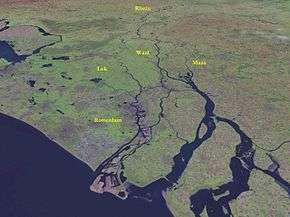
- Waal
- Nijmegen. No rail route follows the course of the Waal exactly. To go to Tiel, you can take an intercity to Elst, then change to an ordinary train to Tiel
- Tiel. The rail link to Gorinchem runs quite distant from the river (you have to change trains in Geldermalsen). If you prefer to follow the river more closely, take a bus to Waardenburg and then another bus to Gorinchem.
The river changes its name to Boven Merwede.
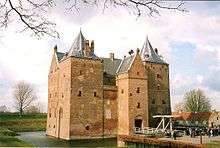
- Loevestein water castle
- Gorinchem. Frequent ordinary trains from here to Dordrecht.
It splits again, into Beneden Merwede and Nieuwe Merwede
- Nieuwe Merwede/Hollands Diep
Nieuwe Merwede becomes Hollands Diep, which again splits into the estuaries Haringvliet and Grevelingen
- Grevelingen
- Schouwen-Duiveland, island south of Grevelingen
- Beneden Merwede/Oude Maas
Beneden Merwede becomes the Oude Maas
- Dordrecht. Very frequent rail links to Rotterdam (intercity or sprinter; only sprinters stop in Zwijndrecht); or bus to Heinenoord, where you can change to another bus to Oud-Beijerland.
- Zwijndrecht
- Oud-Beijerland. Bus to Nieuw-Beijerland, cross the by ferry to Hekelingen and get on another bus to Spijkenisse.
- Spijkenisse. Bus 103 to Brielle or metro line C to Schiedam.
Oude Maas merges with the Nieuwe Maas to form the Nieuwe Waterweg.
- Nederrijn/Lek/Nieuwe Maas
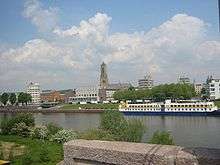
- Arnhem. From here, the rail route runs directly to Utrecht, but you would miss most of the course of the Nederrijn. Instead you can continue by bus to Wageningen.
- Wageningen. There is no direct bus to Wijk, you have to change buses in Doorn.
- Wijk bij Duurstede. Hereafter, no means of public transport follows the course of the river directly. You will have to go to Utrecht to transfer.
The river changes its name to Lek
- Detour to Utrecht: lovely cathedral and university city, about 10 km off the Lek. From Utrecht, you can take a sprinter train to Culemborg, or the hourly Arriva bus line 90 to Rotterdam (via Vianen), or a bus directly to Schoonhoven.
- Culemborg. Bus to Vianen.
- Vianen. You can get on Arriva bus 90 to Rotterdam that hereafter exactly follows the course of the Lek with each of its curves and many stops (including Nieuwpoort, Gelkenes-Schoonhovensever, Kinderdijk).
- Schoonhoven. If you travel on bus 90, get off at Gelkenes-Schoonhovensever and just cross the river by ferry.
- Kinderdijk. The windmills of Kinderdijk are listed as part of the World Heritage.

Confluence with the Noord, continues as Nieuwe Maas.
- Rotterdam. Half-hourly sprinters to Hook of Holland (via Schiedam, Vlaardingen, Maassluis)
- Schiedam. Metro line C from here to Spijkenisse.
- Vlaardingen
Nieuwe Maas merges with the Oude Maas to form the Nieuwe Waterweg.
- Nieuwe Waterweg

- Maassluis
- Brielle
- Europoort Rotterdam
- Hook of Holland (Hoek van Holland), on the mouth of the Nieuwe Waterweg